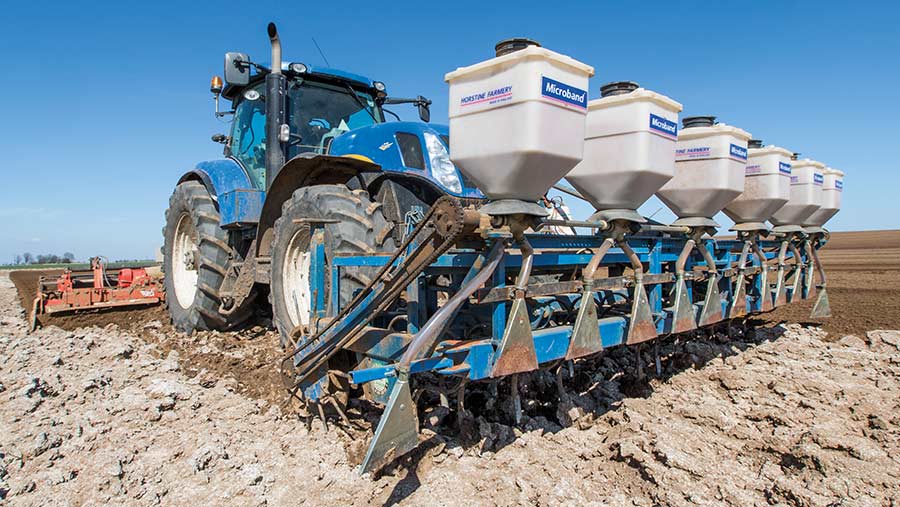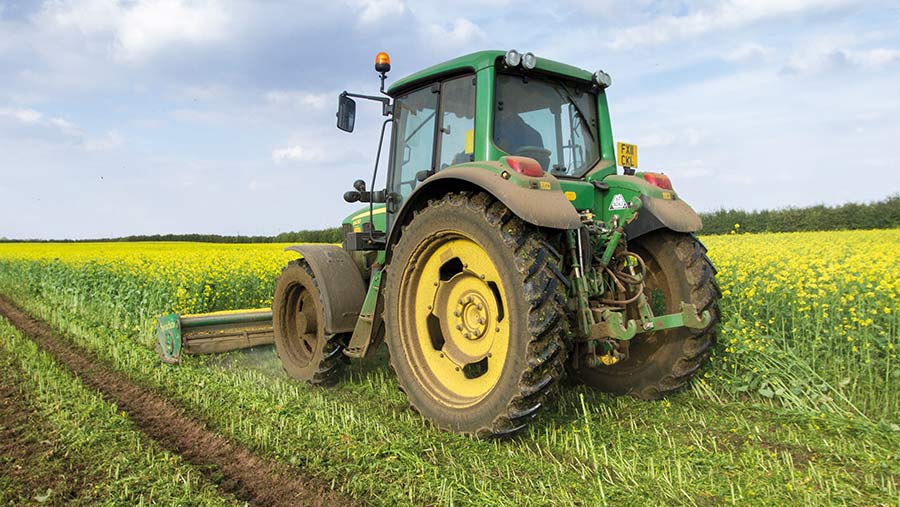4 steps to tackle potato cyst nematodes after granular nematicides
 © Gary Naylor
© Gary Naylor The last remaining granular nematicide for potato cyst nematode (PCN) control, Nemathorin (fosthiazate) faces an uncertain future on UK farms.
While its approval holder, ISK, and marketer Syngenta have invested in new research to help defend it during the EU and UK reregistration procedures, there are no guarantees that they will be successful in obtaining a new approval.
However, Scottish Agronomy’s senior potato agronomist Eric Anderson says ISK and Syngenta are hopeful.
See also: Video: Camera technology improves marketability for potato growers
Current approval timelines give three to four years’ more use in the UK, and while that might seem a reasonable time away, the changes needed in the industry to cope with PCN without any granular nematicides will take at least that long to put in place, Mr Anderson says.
At the recent Cambridge University Potato Growers Research Association (Cupgra) conference, he highlighted four areas where action is needed, or more research required.
1 Transition faster to new varieties
Perhaps the most important requirement for life after granular nematicides will be varietal. The Holy Grail is both resistance and tolerance to PCN, says Mr Anderson.
Resistance helps prevent PCN from multiplying in numbers during potato production, while tolerance maintains yields in the presence of PCN.
“If you grow a resistant variety and it’s not tolerant, you’ll not get a viable yield.”
The most recent PCN survey in 2016 suggested most land was infested with Globodera pallida rather than Globodera rostochiensis, but while good resistance has been bred for the latter, relatively few varieties have good resistance to G pallida.
That’s partly because G pallida has much greater genetic variability than G rostochiensis, making it harder to breed for, Mr Anderson says.
Tolerance is also difficult to identify quickly in breeding programmes as no genetic markers have been identified, although new research linking stem height to tolerance might change that.
Some newer varieties, such as Elland, Karelia, Camel and Eurostar, do have resistance and tolerance to G pallida but, as yet, these varieties make up only a small percentage of potato area and quite often have other weaknesses.
Most varieties grown in East Anglia have very little G pallida resistance, with a similar picture in Scotland.
“There needs to be a step change in the variety profile to be sustainable without nematicides.”
That will take time – it takes five years to build sufficient stocks of commercial grade seed of an existing new variety, and 10 years to breed a new one – but the industry needs to react now because of the risk of revocation of Nemathorin, he says.
“Processors and packers like continuity of supply and will have a big problem if potatoes are not being delivered. There are viable solutions for controlling PCN without nematicides, but they must be willing to change varieties.”
This is starting to happen in the processing sector through companies such as McCain, but short-term thinking is holding back similar change in the packing sector, he suggests. “The industry needs to do more.”
2 Invest in better laboratory results
Without nematicides a greater emphasis will be required on accurate soil sampling, Mr Anderson suggests.
Current sampling is often used to justify nematicide applications, but without them, growers will need to know which PCN species is present to help choose correct varieties – something which isn’t routinely done currently as it is a skilled task that adds time to turnaround.
Accurate information on viable eggs and juveniles, as well as cysts, is also needed to direct management strategies.
Currently, only cyst numbers are provided, with little correlation between cyst numbers and viable egg and juvenile counts.
Detection, particularly of low populations in hotspots, will also be crucial. This is directly correlated to sample size, with at least 400g required to increase detection probability.
Most labs are subsampling to use 100-200g samples, decreasing accuracy of detecting populations under 100 eggs/g.
“Growers will need accurate population estimates around typical action thresholds of 5-10 eggs/g,” Mr Anderson says.
Improvement in all three areas will need investment in the labs, either in throughput capabilities to cope with larger samples or kit to do automatic quantitative polymerase chain reaction analysis for species analysis.
“Farmers can’t absorb all that cost, so fundamentally the packers, processors and crispers have to pay a realistic amount for cost of growing potatoes, because there is cost involved in adopting an integrated pest management strategy.”
3 Develop new technology to control groundkeepers
Control of potato volunteers – groundkeepers – is important for managing PCN populations through the non-potato rotation.
Research has found an average 16-fold increase in viable eggs and juveniles because of groundkeepers, Mr Anderson says.
New technology could help control volunteers, while minimising chemical use.
Mr Anderson pointed to Soil Essentials’ KORE Artificial Intelligence project (SKAi), which is developing a trainable machine vision platform to identify volunteer potatoes.
“It uses high-resolution imagery for spot spraying. Through this we can reduce the application of chemicals by 90%.”
4 Improve understanding of trap cropping and biofumigation

© Gary Naylor
Biofumigation has emerged as an effective non-chemical control method for PCN, but there is poor understanding of the glucosinolates and isothiocyanates (ITC) volatiles present in the brassica species being used, Mr Anderson says.
“Our current understanding is prop-2-ethyl, 2-phenyl-ethyl and but-3-ethyl are the most important, but we don’t have good profiles of cover crop species and biofumigation crops being used, and also how to grow them.
“For example, the pH of soil is important in driving the chemical production. If the pH is below 5.6, we will drive production of nitriles rather than the mustard gas required. Nitrogen and sulphur nutrition is also critical.”
Similarly with trap crops, such as Solanum sisymbriifolium or De-Cyst Prickly, results show promise, with more than 75% reduction possible in PCN populations. But establishment is inconsistent and impacted on adoption.
Research is ongoing to improve consistency with very shallow drilling depths of below 1.5cm, with moisture retention and seed to soil control important.
“Double rolling also helps, and you need to apply adequate amounts of nitrogen and sulphur to get the best from them.”
Eric Anderson was speaking at the annual Cambridge University Potato Growers Research Association conference held at Robinson College, Cambridge.

